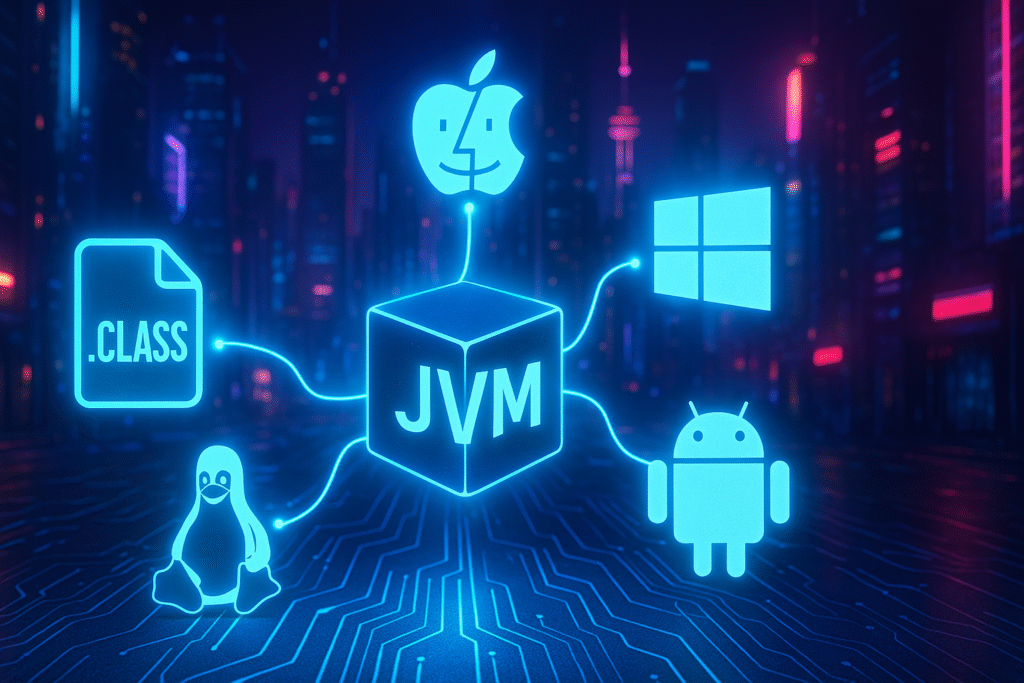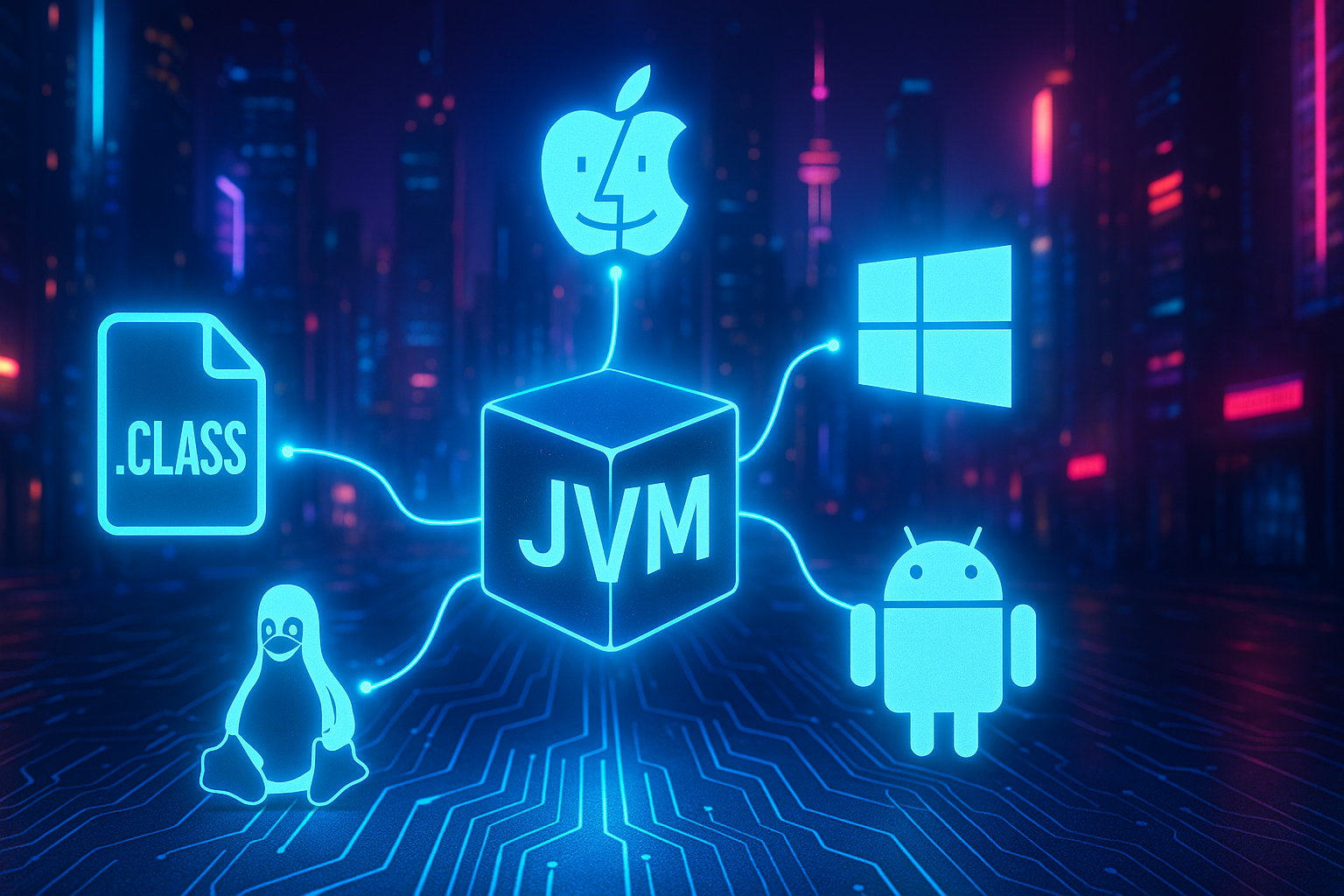Why java is platform independent

Java is platform independent because it uses a clever “write once, run anywhere” approach.
Java’s platform independence is one of its most powerful features, allowing developers to write code once and run it anywhere—whether on Windows, macOS, Linux, or even embedded systems. Here’s a detailed yet simple breakdown of how it works.
The Magic Trick: Bytecode + JVM
Imagine you’re writing a book (your Java program). Instead of publishing it in just English or just Spanish, you:
Write it in a special universal language (Java bytecode)
Give every reader (computer) a translator (JVM) that converts it to their native language
Real-life Example:
You write a Java program on your Windows laptop
Your friend runs the exact same .class file on their Mac
Your server runs it on Linux
It works everywhere without changes!
Why Other Languages Aren’t Like This
Most languages (like C++) compile directly to machine code – it’s like publishing your book only in English:
Works great for English speakers (Windows computers)
Spanish speakers (Macs) can’t read it without a new translation (recompilation)
The JVM – The Universal Translator
The Java Virtual Machine (JVM) is like having a personal interpreter for every computer:
Windows has its JVM
Mac has its JVM
Linux has its JVM
They all understand the same bytecode
public class HelloWorld {
public static void main(String[] args) {
System.out.println("Hello from any computer!");
}
}
You compile this once →
HelloWorld.class(bytecode)This same .class file runs on:
Your Android phone
Your friend’s iPhone
A supercomputer
A smart fridge
The Compromise
There’s one catch – you need to install the translator (JVM) first, just like you’d need to install a language app before reading a book in another language. But once it’s there, any Java program works!
Why This Matters
Developers save time (write once)
Businesses save money (no need for different versions)
Users get consistent experience across devices
That’s why Java became so popular for cross-platform apps like:
Android apps
Banking systems
Enterprise software
Minecraft (yes, the game!)
What Does “Platform Independent” Mean?
Normally, programs written in languages like C or C++ must be recompiled for different operating systems.
Java, however, follows “Write Once, Run Anywhere” (WORA)—meaning the same compiled code runs on any device with a Java Virtual Machine (JVM).
Example:
You write a Java program on Windows.
Compile it into bytecode (
.classfile).Your friend can run the same
.classfile on Mac, Linux, or even a smart TV without recompiling.
How Does Java Achieve This?
A. Java Compiles to Bytecode (Not Machine Code)
When you compile Java code (
Hello.java→Hello.class), it doesn’t turn into Windows.exe or Mac.app.Instead, it becomes bytecode, a universal intermediate format.
B. The JVM (Java Virtual Machine) Acts as a Translator
Each operating system has its own JVM (Windows JVM, Mac JVM, Linux JVM, etc.).
The JVM reads the bytecode and translates it into machine-specific instructions at runtime.
Analogy:
Think of Java bytecode as a universal movie file (like MP4).
The JVM is like a media player (VLC, Windows Media Player, QuickTime).
The same MP4 file plays on any device as long as it has a compatible player.
Why Don’t Other Languages Do This?
Most languages (C, C++, Go, Rust) compile directly to machine code, which is OS-dependent.
| Feature | Java | C/C++ |
|---|---|---|
| Compilation Output | Bytecode (.class) | Machine code (.exe, .dll) |
| Platform Dependent? | ❌ No (Runs anywhere with JVM) | ✅ Yes (Needs recompilation) |
| Example | Minecraft runs on PC, Mac, Linux with same JAR | Photoshop has separate installers for Windows & Mac |
Real-World Examples of Java’s Platform Independence
✅ Minecraft – Same game runs on Windows, macOS, Linux, Raspberry Pi.
✅ Android Apps – Mostly written in Java (or Kotlin, which also uses JVM).
✅ Enterprise Software – Banks and corporations use Java because it works on all servers.
The One Catch: You Need a JVM
Java programs won’t run if the system doesn’t have a JVM installed.
But since JVMs exist for almost every device, this is rarely a problem.
Summary: Why Java is Platform Independent
Source Code → Bytecode (
.java→.class)JVM translates bytecode into machine-specific instructions.
Same
.classfile runs everywhere (Windows, Mac, Linux, etc.).
This is why Java remains a top choice for cross-platform development!
Few cross-platform programming languages :
Several programming languages are cross-platform, but they achieve this differently than Java. Here are the top alternatives and how they compare:
1. Python (Interpreted Language)
How it works: Python code runs via an interpreter installed on each platform.
Strengths:
No compilation needed (directly runs
.pyfiles)Huge library support (NumPy, Django, Flask)
Weakness: Slower than Java due to interpretation.
Example: A Python script works on Windows, Mac, and Linux if Python is installed.
2. JavaScript (Browser & Node.js)
How it works: Runs in web browsers (Chrome, Firefox) or via Node.js.
Strengths:
Universally supported in browsers.
Node.js allows server-side execution.
Weakness: Browser differences can cause minor issues.
Example: A React web app runs on any device with a browser.
3. C# (Via .NET Core / Mono)
How it works: Compiled to Intermediate Language (IL), runs on .NET runtime.
Strengths:
Near-Java performance.
Works on Windows, Linux, macOS (thanks to .NET Core).
Weakness: Historically Windows-centric (but changing).
Example: A .NET Core console app runs cross-platform.
4. Kotlin (JVM Language)
How it works: Compiles to Java bytecode, runs on JVM.
Strengths:
100% interoperable with Java.
Modern syntax (less verbose).
Weakness: Still needs JVM.
Example: Android apps (Kotlin is Google’s preferred language).
5. Go (Compiled, but Cross-Platform)
How it works: Compiled to machine code per platform (but easy cross-compilation).
Strengths:
Fast execution (no VM needed).
Single binary deployment.
Weakness: Less mature ecosystem than Java.
Example: A Go web server compiles separately for Linux and Windows.
6. Rust (Compiled, Cross-Platform)
How it works: Compiled per platform, but toolchain simplifies cross-compilation.
Strengths:
Blazing fast, memory-safe.
No runtime needed.
Weakness: Steeper learning curve.
Example: A Rust CLI tool can be built for Windows, Mac, and Linux.
Comparison Table
| Language | How It Achieves Cross-Platform | Needs Runtime? | Performance | Best For |
|---|---|---|---|---|
| Java | JVM (Bytecode) | ✅ (JVM) | High | Enterprise, Android |
| Python | Interpreter | ✅ (Python) | Medium | Scripting, AI/ML |
| C# | .NET Runtime | ✅ (.NET) | High | Windows apps, Web |
| Kotlin | JVM (Like Java) | ✅ (JVM) | High | Android, Backend |
| Go | Compiled per-platform | ❌ | Very High | Cloud, CLI tools |
| Rust | Compiled per-platform | ❌ | Extremely High | Systems programming |
Which One Should You Choose?
Want “Write Once, Run Anywhere” like Java? → Kotlin (JVM) or C# (.NET)
Need maximum speed without a VM? → Go or Rust
Prefer scripting and fast development? → Python or JavaScript


Leave a Reply